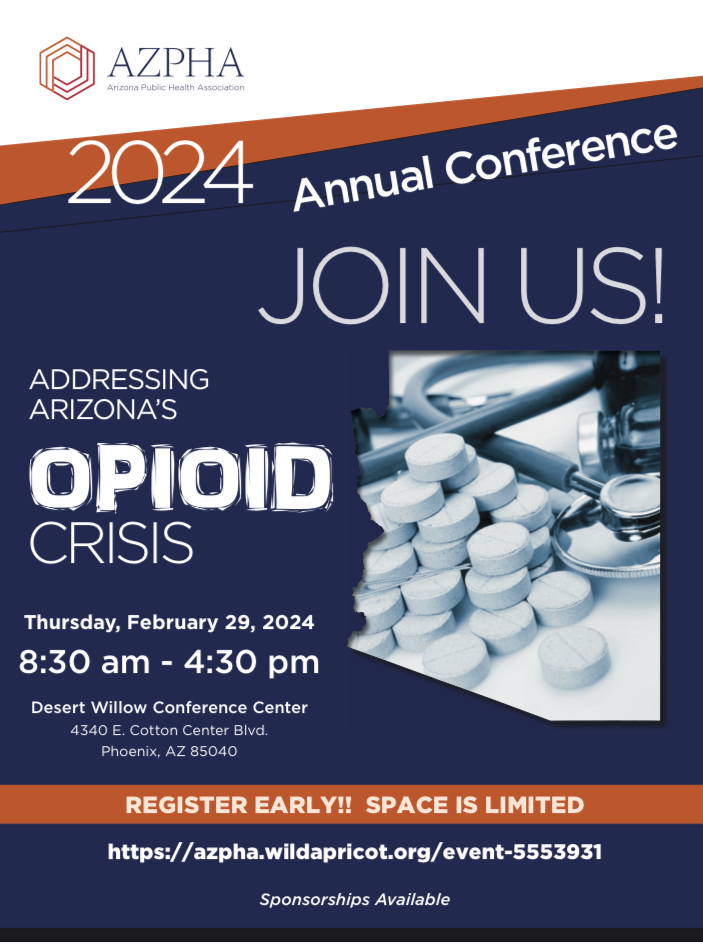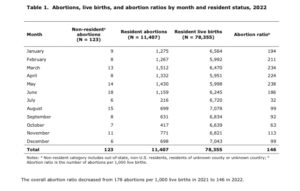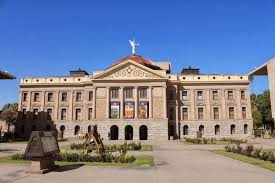AzPHA Annual Conference
Addressing Arizona’s Opioid Crisis
Desert Willow Conference Center
4340 E Cotton Center Blvd, Phoenix, AZ 85040
Thursday, February 29, 2024 (Leap Day)
8:30am – 4:30pm
View Our Conference Agenda*
*Subject to invitation acceptance by presenters
Sponsorship Opportunities
Register Here!
Conference Topics Subject to Final Speaker Confirmation
- Opening Remarks by Arizona Attorney General Kris Mayes (confirmed)
- Closing General Session: AHCCCS Policy, Programs and Resources Targeting the Opioid Epidemic; Increasing Service, Support and Cross-sector Engagement –Catherine Dobler, Polly Knape, et.al. AHCCCS
- Rates & Trends of Opioid/Fentanyl Overdose Deaths in Arizona, 2003-2023: Implications for Public Health Policy – Allan Williams, PhD & Will Humble, AZPHA
- Statewide overdose surveillance: strategies from the overdose data to action program at the ADHS – Martín Celaya, MPH , ADHS & Charles Katz, PhD – Arizona State University
- Findings from a Mixed-Methods Needs Assessment of People Who Use Drugs — Maricopa County, AZ, April–June 2023 – Christina Mrukowicz – Maricopa County Department of Public Health
- Risks from opioid use during extreme heat- Marisa Domino – ASU, Center for Health Information and Research
- Collaborative problem solving in rural communities to address the opioid crisis – Rocio Torres – Arizona Center for Rural Health & Christy Crowley – Easter Seals
- Collaborative efforts in rural consortium of SUD/OUD partners to support youth and young adults along the US-Mexico border – Yara Castro & Tsion Meles Mariposa Community Health Center
- Perceptions of overdose risks among persons who use illicitly manufactured fentanyl in Phoenix, Arizona – Raminta Daniulaityte & Kaylin Sweeney – ASU College Health Solutions
- From Stigma, to Hope, to Healing: Maricopa SHIFT: Safe, Healthy Infants and Families Thrive Clay Jones, M.Ed., IMH-E Maricopa County Department of Public Health
- A Citywide Approach to Opioid Response Planning – Nicole Witt, MPH & Yanitza Soto – City of Phoenix Public Health Advisor Office of Public Health
- A Tale of Two Cities: An Overview of Opioid Use Prevention Initiatives in Phoenix, AZ and Kansas City, KS – Jeffery Hanna, MPH, MSc & –Justin Zeien, MD, MPH Zeihan Prohealth Consulting, LLC
- Evidence to Action: Reducing Opioid Overdoses in Arizona through Medical and Pharmacy Practice Change- Beth Meyerson – Harm Reduction Research Lab, UArizona College of Medicine-Tucson
- Expanding MOUD Prescribers: How the Arizona State University Edson College of Nursing is addressing the Opioid epidemic – Ann Guthery PhD, PMHNP-BC & Matthew Martin– ASU
- The Yavapai County Connection Center: Serving recently incarcerated individuals, addressing the challenges of housing-employment-food insecurity, mental health needs, and substance abuse. James Tobin & Beya Thayer – Yavapai Community Health Services
- MCDPH Fellowship: Catalyst for Change in Maricopa County’s Correctional Health Services- Tori Osmundson Maricopa County Department of Public Health & Megan Baker – Maricopa County Correctional Health Services
- Access to treatment for incarcerated individuals experiencing opioid withdrawal in the Maricopa County, Arizona Jail System – Matthew Martin, PhD &Swetha Gansan, MS- ASU College of Health Solutions
- Using Overdose Data to Transform Care: What Data Matters- Amanda Sapp – Pima County Health Department
- Data to Action: Opioid Surveillance, Fatality Review, and Prevention Measures in State Public Health – Ginger Dixon & Mercedeh Reamer, MPH – ADHS
- From Overdose to Treatment & Recovery – Andy Sparks Director of Commercial Development at Integrative Strategies: Combining Medicine, Peer Support, and Care for Opioid Recovery – Riley Monahan & Barbara Lee – Crossroads
- Beyond Free Narcan. A Proposal for Meaningful Legislative Changes to Combat the Opioid Crisis – Hon. Gary E. Donahoe Judge of the Arizona Superior Court (ret.) & Jahanzeb Ali Khan, MD – Crossroads
- Perinatal Harm Reduction – Danielle Treiber Sonoran Prevention Works
- The Impact of Opioids on Maternal and Child Health and Strategies to Improve Outcomes in Arizona – Aubrianna Perez & Morgan Anderson – ADHS
- Public Health & Libraries Harm Reduction Partnership – Mark Person & –Kate DeMeester-Lane – Pima County Health Department
- Turning the Page on Opioids: Libraries as Community Partners – Dana Abbey Network of the National Library of Medicine, Engagement Specialist
- Saving Lives: Strategies and Successes of the City of Phoenix Naloxone Program – Yanitza Soto, MPH City of Phoenix Special Project Administrator Office of Public Health & Dominic Orso, MBA – Maricopa County Public Health
- Naloxone Leave Behind in Arizona – Julia Vinton & Adam Rodriguez– ADHS








